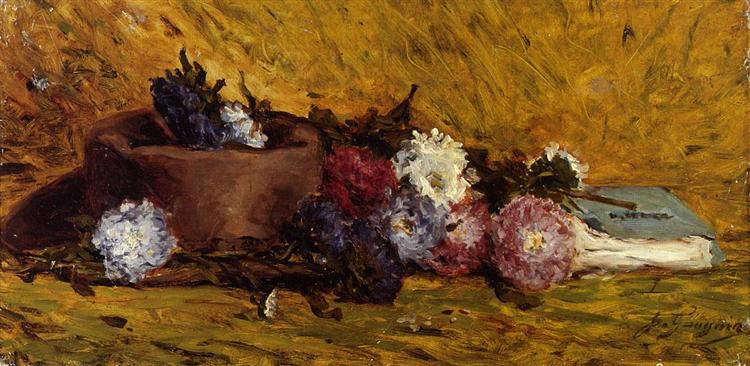Description
Paul Gauguin's "Asters of China - Hat and Book", painted in 1876, represents a fascinating example of the exploration of colour, form and composition that characterises the artist's early work. In this painting, Gauguin displays a mastery in the depiction of everyday objects, whilst introducing a deeply personal and evocative pictorial language.
The composition of the work is centered on a straw hat, a work of art in its own right, which is prominently displayed at the bottom left of the canvas. This hat, with its delicate construction and elaborate detailing, becomes the visual anchor of the painting. Next to the hat is a book that rests almost casually, suggesting a moment of contemplation or relaxation, aspects that are equally central to Gauguin’s artistic life. The position of the hat and the book, almost as if they are waiting for their owner, evokes a sense of intimacy and stillness.
The background of the work is dominated by a vibrant, lush field of Chinese alstroemeria, which not only gives the painting its name but also infuses the composition with energy. The colours in this part are intense and saturated, from the purples and lilacs of the flowers, to the deep greens of the leaves. This expressive use of colour, a choice that is more emotional than descriptive, is a distinctive trait of Gauguin, who was moving away from the more muted and natural tones of the Impressionists who preceded him. The way the flowers are arranged on the canvas suggests organic movement, a visual dance that envelops the hat and the book, drawing the viewer’s gaze in an almost hypnotic way.
Gauguin's style during this period can be seen as a transition towards what would later be known as Symbolism. Although "Asters from China - Hat and Book" still adheres to Impressionist influences in its use of color and light, it already bears hints of the artist's quest for a more spiritual and allegorical representation of reality. Rather than simply capturing the light of the moment, Gauguin seems to be more interested in the essence and meaning of the objects in his environment. Here, the hat and book may symbolize art and culture, while the flowers represent life and ephemeral beauty.
It should also be noted that this work is a clear reflection of Gauguin's personal and artistic environment at the time. After his return to France from Tahiti in 1885, his works began to explore more exotic and spiritual themes, but "Asters from China - Hat and Book" serves as a reminder of his roots and his journey before embracing his famous post-impressionist style.
Upon close inspection, one can appreciate the evocative texture of the painting, with the impasto palpable in certain areas, a technique Gauguin employed to create depth and visual richness. This gesture aligns with his preference for breaking with tradition, offering the viewer not only an image but also a physical and emotional connection to the experience of seeing.
In conclusion, “Asters from China – Hat and Book” is a work that encapsulates the essence of Gauguin’s artistic exploration at a time of personal and aesthetic change. The interplay of light, colour and form, together with the simplicity of the objects depicted, offers us a deep insight into his inner world and a rich dialogue that continues to resonate to this day. This work, in its apparent simplicity, opens up a vast space for reflection, being a clear precursor to the innovations that would come later in his career.
KUADROS ©, a famous painting on your wall.
Hand-made oil painting reproductions, with the quality of professional artists and the distinctive seal of KUADROS ©.
Painting reproduction service with satisfaction guarantee. If you are not completely satisfied with the replica of your painting, we will refund 100% of your money.

